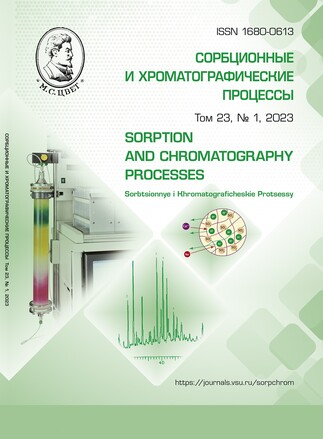Size-exclusion chromatography of furan resins synthesized by an electro (photo)chemical method
Abstract
The synthesis of furan resins was carried out using electro- and photoelectrochemically initiated polymerization of furfuryl alcohol and its propylene chlorohydrin ether. These methods have a number of advantages over chemical methods. Firstly, reaction product are films with good electrical conductivity, localized already on an electrode surface. Another advantage of the method is the high stoichiometry of the process, which allows controlling the properties of the molecular weight distribution of the polymer in the process of its production. The results of size exclusion chromatographic studies demonstrated that the process of polymerization of these compounds using these methods occurs according to two different mechanisms. Thus, in the first case, polymerization proceeds with the formation of a low molecular weight furan resin in the form of an individual trimer and pentamer, and in the second case, upon photoelectrochemical initiation, the reaction proceeds according to the mechanism of polymerization of dienes formed upon opening of the furan ring with the formation of linear oligodienes, consisting of elementary links with one double bond. It was shown that with the increase in illumination from 20·103 up to 30·103 Lux, the initiation of furfuryl alcohol was accompanied by the formation of oligomers, with molecular weights fluctuating in the range of 3220-4175 (Mw) and 2300-2960 (Mn) and the initiation of propylene chlorohydrin ether under the same conditions led to the formation of oligomers with increasing molecular weights from 7345 to 9430 and from 4680 to 6110 (Mn), before Mw=9430 and Mn =6110. The yield of polymerization products of the starting monomers also increased from about 45% to 70%. The electro- and photoelectrochemical initiation of the monomers was carried out under the same conditions. Only in the second case, incandescent lamps of various powers of 150, 300, and 500 W were used, graphite served as anode and cathode. The electrolyte was an aqueous solution of sulphuric acid (0.5 M H2SO4). The sample dissolved in dimethylformamide, together with the background electrolyte, was placed in an electrolytic cell equipped with a graphite cathode and anode. The initiation was carried out at a current density of 0.1-0.15 A/cm2 and temperature within 40-50oC with irradiation of the reaction zone with visible light. The time required for oxidative polycondensation was from 8 to 10 hours.
Downloads
References
Zefirov N.S., Kulov N.N. Chemical encyclopedia. Vol. 5. M.: Big Russian En-cyclopedia, 1998. 783 p. (In Russ.)
Nikolaev A.F., Kryzhanovsky V.K., Burlov V.V. Polymer materials technology: textbook. manual for specials. Chem. tech-nology of high molecular weight com-pounds under total. ed. VC. Kryzhanovsky. SPb : Professiya, 2008. 533 с. (In Russ.)
Gilchrist T. Chemistry of Heterocy-clic Compounds. M.: Mir, 1996. 464 p. (In Russ.)
Mamatov Yu.M. Polymer materials based on furan resins and their application. M.: Khimiya. 1975. 97 p. (In Russ.)
Bessonov N.V., Kopytsina M.N., Ne-lyub V.A. Synthesis of furfuralideneacetones. J. of General Chemistry. 2014; 84(12): 2023.
Tarasevich M.R., Orlov S.B., Shkolnikov E.I. Electrochemistry of Poly-mers. M. Nauka, 1990. 238 p.
Kuliyev E.M., Bektashi N.R., Aslanov T.A. Molecular weight distribution of the products of the oligomerization reaction of ethylenediamide disulfoimide of disaccharincarboxylic acid synthesized by photoelectrochemistry. Chemical Problems. 2014; 2: 169.
Bektashi N.R., Kuliev E.M. Photoelectrochemical oligomerization of β-chlorobutyl methacrylate. Modern concepts of scientific research. Monthly scientific journal. 2015; 7(3): 156.
Bektashi N.R. Investigation of the structural heterogeneity of oligomers by high performance liquid chromatography. Sorbtsionnye I khromatograficheskiye protsessy. 2018; 18(1): 64-72.







